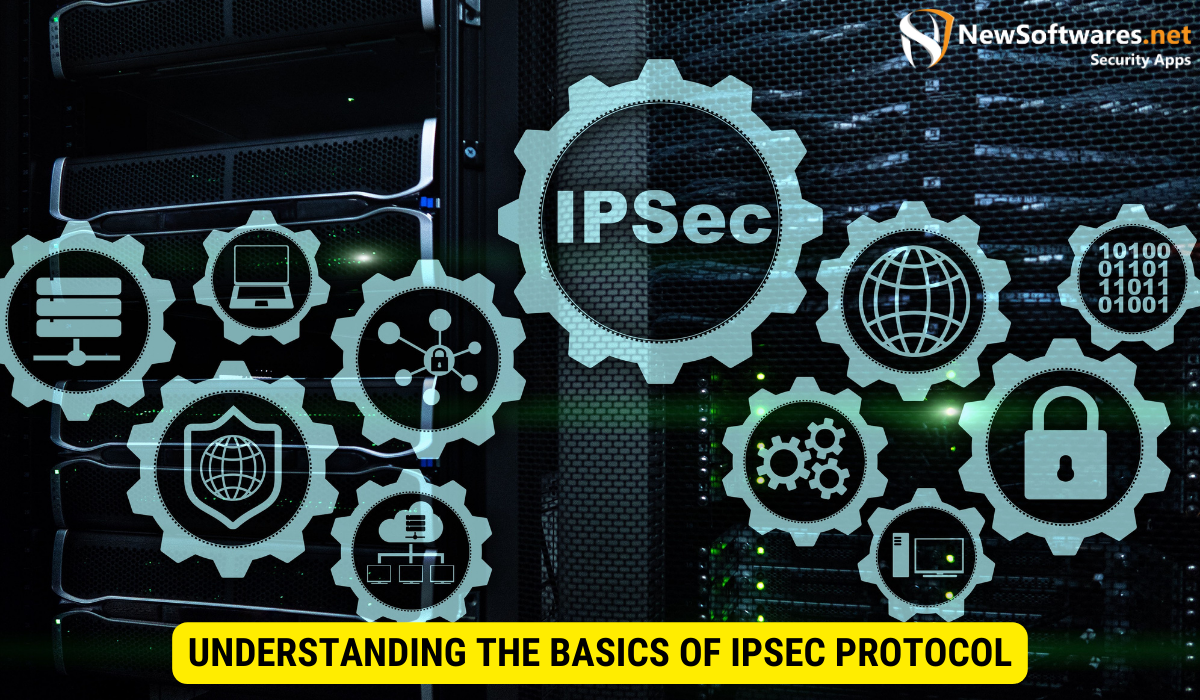The Encapsulating Security Payload (ESP) protocol within IPSec provides confidentiality by encrypting data in network communications.
In network security, confidentiality is essential to protecting sensitive data from unauthorized access. Internet Protocol Security is a protocol that offers confidentiality by encrypting data. IPSec is a suite of protocols that operates at the complex network layer of the OSI (Open Systems Interconnection) model and offers a range of security services, including privacy, integrity, and authentication.
Understanding the Basics of IPSec Protocol

Before diving into the specifics of how IPSec provides confidentiality through data encryption, it’s crucial to understand the fundamental aspects of the protocol. IPSec is vital to network security by ensuring secure data transmission across networks, regardless of the underlying protocols.
IPSec, short for Internet Protocol Security, is a protocol suite operating at the OSI model’s network layer. It provides a framework for securing IP communications by authenticating and encrypting each IP packet.
One of the key benefits of IPSec is its ability to establish secure tunnels between two devices, allowing them to communicate securely over an untrusted network such as the Internet. This is particularly important for organizations that need to connect remote offices or enable secure remote access for their employees.
The Role of IPSec in Network Security
IPSec acts as a security layer by encrypting the IP packets, making it extremely difficult for hackers or malicious entities to intercept and decipher the information. It safeguards the confidentiality, integrity, and authenticity of network communication.
Confidentiality is achieved through encryption, where cryptographic algorithms transform the original data into an unreadable format. Only authorized parties with the appropriate decryption keys can access the original information.
Integrity ensures that the data remains unchanged during transmission. IPSec uses cryptographic hash functions to generate a unique checksum for each packet. The receiving device can verify the packet’s integrity by recalculating the checksum and comparing it with the received value.
Authenticity is established through the use of digital signatures or certificates. These mechanisms verify the identities of the communicating entities, preventing unauthorized access and ensuring that the data comes from a trusted source.
Key Components of IPSec Protocol
IPSec comprises several key components that provide a secure communication channel. These components include:
- Security Association (SA): SA represents a logical connection between two devices and includes parameters such as shared secret keys and cryptographic algorithms. It defines the security parameters for the IPSec communication, such as the encryption and authentication algorithms.
- Encryption Algorithms: IPSec supports various encryption algorithms, such as AES (Advanced Encryption Standard), 3DES (Triple Data Encryption Standard), and Blowfish, to ensure the confidentiality of data. These algorithms use complex mathematical operations to transform the original data into ciphertext, which can only be decrypted with the corresponding decryption key.
- Authentication Mechanisms: IPSec employs digital certificates, pre-shared keys, or public key infrastructure (PKI) to verify the identities of communicating entities. These mechanisms ensure the data is exchanged between trusted parties and protect against impersonation or replay attacks.
- Key Management: Proper key management is critical for the secure operation of IPSec. It involves generating, distributing, and securely updating encryption keys between devices. Key management protocols, such as Internet Key Exchange (IKE), establish and maintain the cryptographic keys required for IPSec communication.
Combining these components, IPSec provides a robust and flexible framework for securing network communication. It can be implemented in various modes, such as transport mode, where only the payload of the IP packet is encrypted, or tunnel mode, where the entire IP packet is encapsulated within a new IP packet for secure transmission.
Overall, IPSec is a crucial protocol for ensuring network communication’s confidentiality, integrity, and authenticity. Its ability to establish secure tunnels and protect against unauthorized access makes it an essential tool for organizations seeking to secure their data and maintain the privacy of their network communications.
Exploring the Different IPSec Protocols
IPSec encompasses various protocols that provide specific functionalities within the IPSec framework. Two core protocols widely used in IPSec are the Authentication Header (AH) protocol and the Encapsulating Security Payload (ESP) protocol.
Overview of Authentication Header (AH) Protocol
The Authentication Header (AH) protocol serves multiple purposes, including data integrity, source authentication, and protection against replay attacks. It achieves this by appending a fixed-length authentication header to the IP packets, containing a cryptographic hash of the packet contents and additional parameters.
Insights into Encapsulating Security Payload (ESP) Protocol
The Encapsulating Security Payload (ESP) protocol offers a broader range of security services than the AH protocol. Apart from ensuring data integrity and source authentication, ESP provides confidentiality through encryption. It encapsulates the IP packets with additional headers that carry the encrypted payload, ensuring secure transmission across networks.
Confidentiality and Encryption in IPSec
To understand how IPSec provides confidentiality, it is essential to grasp the data security concept and the role of encryption in the process.
The Concept of Confidentiality in Data Security
Confidentiality refers to the protection of information from unauthorized access. In data security, confidentiality ensures that data remains inaccessible to unauthorized individuals and entities. By encrypting data, IPSec prevents unauthorized individuals from comprehending the contents of the transmitted information.
How Encryption Works in IPSec?
In IPSec, encryption is achieved through the ESP protocol. Once a secure connection, known as the Security Association (SA), is established between two devices, the ESP protocol provides confidentiality by encrypting the payload of the IP packets. This encryption process scrambles the content of the packets and renders them unreadable without the appropriate decryption keys.
Identifying the IPSec Protocol for Data Encryption
When selecting an IPSec protocol for data encryption, it’s essential to examine the effectiveness and suitability of different options.
Evaluating the Effectiveness of ESP for Encryption
The Encapsulating Security Payload (ESP) protocol within IPSec is highly effective for providing encryption services. It offers various encryption algorithms, each with its advantages and compatibility considerations. By evaluating factors such as the desired level of security, performance impact, and device compatibility, organizations can determine the most suitable encryption algorithm for their specific requirements.
Why ESP is Preferred for Providing Confidentiality?
ESP is preferred for confidentiality due to its ability to offer encryption and authentication services. While the Authentication Header (AH) protocol ensures integrity and source authentication, ESP combines these features with content encryption, making it a comprehensive choice for confidentiality in IPSec.
Implementing IPSec Protocol for Data Encryption

Implementing IPSec protocol for data encryption requires careful configuration and adherence to best practices.
Steps to Configure ESP for Data Encryption
The following steps outline the process of configuring ESP for data encryption:
- Identify the communication endpoints that need to establish a secure connection using IPSec.
- Establish a Security Association (SA) between the endpoints, ensuring consistency in parameters like encryption algorithm, authentication method, and key management.
- Configure the IPSec policies on the devices involved, ensuring that the desired traffic is subject to encryption.
- Monitor the IPSec implementation for potential issues or conflicts, ensuring the established secure connection functions are as intended.
Best Practices for Implementing IPSec Encryption
Implementing IPSec encryption effectively entails following best practices for optimum security and performance. Some recommended practices include:
- Regularly reviewing and updating encryption keys.
- Monitoring IPSec logs and security alerts for any suspicious activities or breaches.
- Implementing strong authentication mechanisms, such as certificates or two-factor authentication, to ensure the secure identification of communicating entities.
- Conducting periodic audits and vulnerability assessments to ensure the ongoing effectiveness of the IPSec implementation.
- Regularly updating the IPSec software and firmware to incorporate the latest security patches and enhancements.
Key Takeaways
- To summarize, IPSec protocols play a crucial role in providing confidentiality by encrypting data in network communications.
- The ability to secure transmitted information helps safeguard against unauthorized access and potential data breaches.
- By understanding the basics of IPSec, exploring the different protocols, and implementing best practices, organizations can establish robust data encryption mechanisms that contribute to a secure network environment.
FAQs
What is the primary purpose of IPSec protocols?
The primary purpose of IPSec protocols is to provide secure communication by ensuring privacy, integrity, and authenticity through encryption, authentication, and other security mechanisms.
How does the Authentication Header (AH) protocol contribute to network security?
The Authentication Header (AH) protocol verifies the integrity and authenticity of IP packets, protecting against tampering and source spoofing. It appends an authentication header with a cryptographic hash of the packet contents.
Which IPSec protocol offers both encryption and authentication services?
The Encapsulating Security Payload (ESP) protocol within IPSec provides encryption and authentication services, making it a comprehensive choice for confidentiality in network communication.
Is ESP the only protocol available for data encryption in IPSec?
Apart from the Encapsulating Security Payload (ESP) protocol, other encryption protocols like AH also belong to the IPSec suite. However, AH primarily focuses on integrity and authentication rather than encryption.
What are some common challenges in implementing IPSec for data encryption?
Some common challenges in implementing IPSec for data encryption include device compatibility issues, configuration errors, performance impact, and the management of encryption keys.
Conclusion
Confidentiality in data security is a critical aspect of protecting sensitive information. The IPSec protocol provides confidentiality by encrypting data preventing unauthorized access to the contents of IP packets. Organizations can establish robust data encryption mechanisms by understanding the basics of IPSec, exploring different protocols like AH and ESP, and following best practices for implementation. This ensures secure transmission of information and contributes to a secure network environment.
